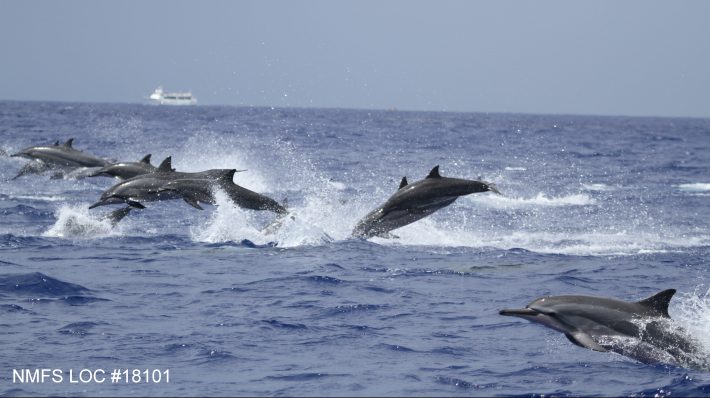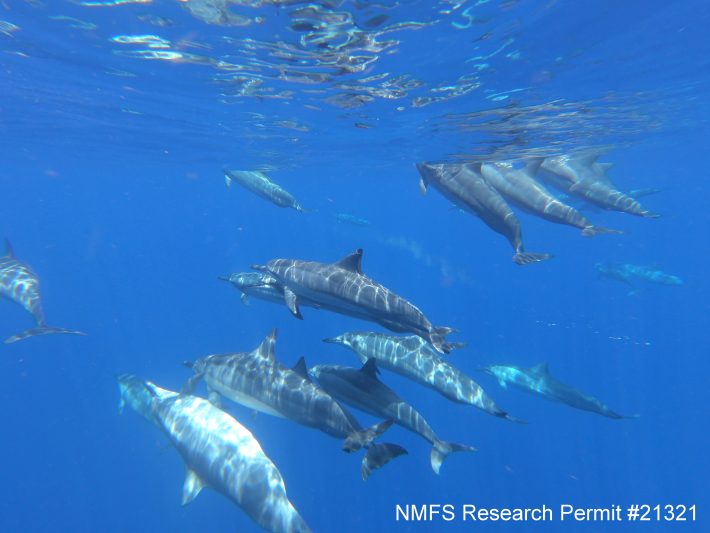PWF uses tour vessels to examine the distribution of dolphins in Hawaii
Pacific Whale Foundation press release.
Pacific Whale Foundation (PWF) researchers harness data collected by tourists in Hawaii to examine the distribution of four dolphin species. The findings are published in Ecological Solutions and Evidence.

Researchers at Pacific Whale Foundation (PWF), a nonprofit organization protecting the ocean through science and advocacy since 1980, used data collected from tour vessels to publish new findings gleaned from a dolphin distribution study that support the benefits of and need for public participation in research efforts.
University of Aberdeen graduate student (and former PWF research intern) Holly Self led the study, which took place in the waters of Maui Nui. The study’s corresponding scientific paper was co-authored by Pacific Whale Foundation (PWF) researchers Stephanie Stack and Jens Currie, in partnership with David Lusseau of the National Institute of Aquatic Resources, Danish Technical University and published in the scientific journal, Ecological Solutions and Evidence.
Headquartered on the island of Maui, PWF is well situated to engage in extensive research on the impact of human activity on ocean wildlife throughout the Hawaiian Islands — a marine ecoregion of global importance. The study focused on the four most frequently sighted species in Maui Nui — the Pantropical spotted dolphin, the spinner dolphin, the common bottlenose dolphin and the more elusive false killer whale — and revealed a concerning lack of applicable information regarding the distribution of these populations.
“Detailed monitoring of dolphin populations, particularly when we want to find out where they spend more time, requires multi-annual dedicated survey effort which is difficult to maintain,” Lusseau explains. “Novel analytical techniques are allowing us to make use of reports coming from the community and from varied vessels who spend a lot of time on the water, like whale-watching operators, to gain insights into the ways dolphin species use a region.”
The distribution for all species studied differed when calves were present
Self, whose master’s thesis contributed to the evolution of this paper, parlayed her lifelong fascination with marine environment into an internship with PWF. “My time as a PWF research intern prompted the questions which went on to become my research project once I started my master’s work at the University of Aberdeen, which then grew from there into a broader piece of work and led to this article,” she acknowledges. “I’ve been greatly inspired by people I’ve met and worked with who taught me that there’s a place for everyone in pursuing marine science and working towards real conservation change.”
The paper examines several key findings of the study: the distribution for all species studied differed when calves were present; sighting events of all species studied varied significantly depending on the season, with bottlenose dolphins and false killer whales more prevalent in winter and spotted and spinner dolphins more prevalent in the summer months; evidence that an overlap in the distribution of dolphin schools with calves and vessel traffic in the region could result in collision and chronic stress risks, suggesting a need for specific regulations for mitigating anthropogenic influences such as acoustic disturbance or chronic energetic disturbance from vessel traffic — an area of conservation concern specifically for the endangered population of false killer whales and for spinner dolphins.

“Due to the challenges in consistent observation of these four species, we do not know the extent of the risks human activity present in the conservation of these specific dolphin populations,” Stack notes.
To effectively manage anthropogenic impacts on species requires detailed data on the spatial and temporal distribution of these mobile species. While there are dedicated research groups working in the main Hawaiian Islands, community contributions are a useful form of supplementary material and often have spatial or temporal coverage that research surveys alone cannot achieve.
Stephanie Stack:
Members of the public who document their observations via the Whale & Dolphin Tracker app are instrumental in helping us fill information gaps.
Capitalizing on opportunistic research (the term applied to observation and documentation of wildlife beyond the purview of systematic scientific study) as a data source, PWF created the Whale & Dolphin Tracker app which allows anyone involved in an ocean activity or sport to become a “community scientist” and potentially impact future policy in support of PWF’s marine conservation efforts.
Data entered into the Whale & Dolphin Tracker app provides PWF researchers and conservation partners with supplemental information vital to current and future studies of odontocetes and other marine mammals. The profusion of whale-watch tours, snorkelling excursions, fishing trips and pleasure cruises exponentially increases the number of eyes on the water. Tapping into this abundant source of data through encouraging the use of the Whale & Dolphin Tracker app to document a sighting or interaction with vulnerable species has great implications in mitigating threats to these populations.
“Private and commercial boats are out on the water daily while research vessels generally adhere to a more restricted schedule,” Stack explains. “Members of the public who document their observations via the Whale & Dolphin Tracker app are instrumental in helping us fill in gaps of information vital to ongoing study and threat mitigation efforts.”
Community scientists who wish to contribute to PWF research data by recording sightings using the Whale & Dolphin Tracker app, can click here or visit PacificWhale.org/research/hawaii-wdt-sightings-map.
You can read the article in full here:
, , , & (2021). Tourism informing conservation: the distribution of four dolphin species varies with calf presence and increases their vulnerability to vessel traffic in the four-island region of Maui, Hawai‘i. Ecol Solut Evidence, 2:, e12065. https://doi.org/10.1002/2688-8319.12065
Media Contact:
Joana Costa Marques, Eleven Six PR
(305)-491-6547
joana@elevensixpr.com
Like what we stand for?
Support our mission and help develop the next generation of ecologists by donating to the British Ecological Society.